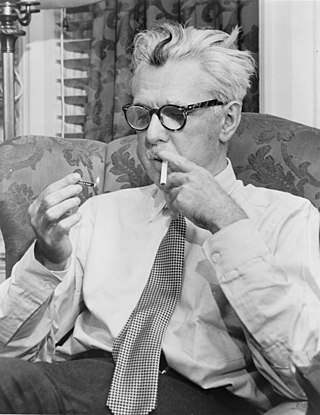
James Grover Thurber was an American cartoonist, writer, humorist, journalist and playwright. He was best known for his cartoons and short stories, published mainly in The New Yorker and collected in his numerous books.

The Ohio State University, commonly called Ohio State or OSU, is a public land-grant research university in Columbus, Ohio. A member of the University System of Ohio, Ohio State was founded in 1870 as the state's land-grant university and the ninth university in Ohio with the Morrill Act of 1862. Ohio State was originally known as the Ohio Agricultural and Mechanical College and focused on various agricultural and mechanical disciplines, but it developed into a comprehensive university under the direction of then-Governor and later U.S. president Rutherford B. Hayes, and in 1878, the Ohio General Assembly passed a law changing the name to "the Ohio State University" and broadening the scope of the university. Admission standards tightened and became greatly more selective throughout the 2000s and 2010s. As of 2021, Ohio State has the most students in the 95th percentile or above on standardized testing of any public university in the United States. It is classified among "R1: Doctoral Universities – Very high research activity". The university's endowment of $7.0 billion in 2022 is among the largest in the world.

Jeff Smith is an American cartoonist. He is best known as the creator of the self-published comic book series Bone.

Elwood Gordon Gee is an American academic. As of 2020, he was serving his second term as President of West Virginia University; his first term was from 1981 to 1985. Gee has held more university presidencies than any other American. He was head of University of Colorado Boulder from 1985 to 1990, of Ohio State University from 1990 to 1997, of Brown University from 1998 to 2000, of Vanderbilt University from 2000 to 2007, and of Ohio State University for a second time from 2007 to 2013. Time rated Gee one of the top 10 college presidents in the United States for 2010.
Paul Palnik was an American artist, writer and educator. He was born in Cleveland, Ohio, and resided in Columbus, Ohio.

The Lantern is an independent daily newspaper in Columbus, Ohio, by students at Ohio State University. It is one of the largest campus newspapers in the United States, reaching a circulation of 15,000.

Thurber House is a literary center for readers and writers located in Columbus, Ohio, in the historic former home of author, humorist, and New Yorker cartoonist James Thurber. Thurber House is dedicated to promoting the literary arts by presenting quality literary programming; increasing the awareness of literature as a significant art form; promoting excellence in writing; providing support for literary artists; and commemorating Thurber's literary and artistic achievements. The house is individually listed on the National Register of Historic Places, and also as part of the Jefferson Avenue Historic District.

The Ohio State University at Mansfield is a satellite campus of Ohio State University in Mansfield, Ohio. It was founded in 1958 as a land-grant college and occupies a 644-acre (2.61 km2) campus that is shared with North Central State College. The campus offers ten bachelor degree programs and graduate level coursework in education. The campus practices open admissions. Students can start at Mansfield and finish their degrees at The Ohio State University, Columbus, with one or more of Ohio State’s 200+ majors. The Bromfield Library of the Ohio State Mansfield campus provides access to all the resources of the Ohio State University and Ohio Link.

The Arthur G. James Cancer Hospital and Richard J. Solove Research Institute is part of The Ohio State University and one of the 45 National Comprehensive Cancer hospitals. It is named after Arthur G. James, the founder, who desired a cancer hospital in Columbus, Ohio, United States.
The University District, is a 2.8-square-mile (7.3 km2) area located 2 miles (3.2 km) north of Downtown Columbus, Ohio that is home to the main campus of Ohio State University, the Battelle Institute, and Wexner Medical Center. It is generally accepted as the area bounded to the north by Clintonville at Glen Echo Ravine; to the south by the Short North at 5th Avenue; to the west by the Olentangy River and to east by the Conrail railroad tracks. Points of interest include, but are not limited to, the Ohio Stadium and Old North Columbus. The district is Columbus' most densely populated area and contains more than 650 businesses, human service agencies, churches, and schools. University District businesses include boutiques, mixed retail, several tattoo studios, the Gateway Film Center, and a diverse range of restaurants and bars.

East High School is a public high school located on the near east side of Columbus, Ohio at 1500 E. Broad Street. It is a part of Columbus City Schools. It was originally constructed in 1922.

Mirror Lake is a pond on the campus of the Ohio State University in Columbus, Ohio. Visitors, students, faculty, and staff visit the fountains that run in spring, summer, and autumn.
Gardner Rea was an American cartoonist, and one of the original contributing artists to The New Yorker. Of Rea, one commentator has written: “He was bawdy without being obscene, absurd without being obscure. His captioned and uncaptioned gags were pithy and true.”
The culture of Columbus, Ohio, is particularly known for museums, performing arts, sporting events, seasonal fairs and festivals, and architecture of various styles from Greek Revival to modern architecture.

Watts Hall was a building on the Ohio State University campus, in Columbus, Ohio, United States. The building was named after Arthur S. Watts, a former head of the Department of Ceramic Engineering, and former president of the American Ceramic Society. It housed the OSU Department of Materials Science and Engineering before being demolished in 2022 to make way for the second phase of the BMEC project.

Mitra Jouhari is an Iranian-American comedian, actress, and writer. She is best known for starring in the television series Three Busy Debras, based on the sketch comedy group she co-founded, and voicing Cleopatra "Cleo" Smith in the second season of Clone High. Jouhari has written for the television series Big Mouth, High Maintenance, and Miracle Workers.

The Jewish community of Greater Columbus has made up a small but noteworthy part of the region since the arrival of Jews in 1840. The community has gone through periods of growth, especially in the last quarter of the 20th century. Today, the well-established community includes schools, temples, elder care facilities, kosher food services, ritual baths, social clubs, community religious learning centers and other organizations and has a population of approximately 25,500, as of the most recent 2013 study. It is the 43rd largest Jewish community in the United States and the third largest in Ohio, trailing Cleveland and Cincinnati.

The College of Arts and Sciences is one of sixteen colleges at Ohio State University. The college is the largest at Ohio State, and is located in several buildings throughout its campus. The college is composed of 38 departments, and hosts over 80 different majors.















